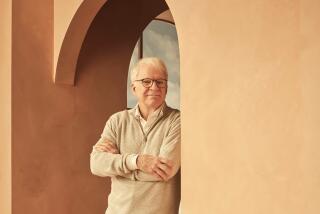Hollywood’s Oldest Storyteller : Soon to be 100, the man who put Harold Lloyd, ‘Our Gang’ and Laurel and Hardy on the screen has a lot to talk about
- Share via
The longevity honors among major Hollywood figures are still held by Adolph Zukor, the founder of Paramount, who was in his 103rd year when he died in 1976. A friend remembers meeting Zukor and a companion at lunch at the Hillcrest Country Club. “You know my kid,” Zukor said by way of introducing his companion.” His son was 75. A possibly apocryphal line attributed to Zukor had him say, “If I’d known I was going to live this long, I’d have taken better care of myself.”
Zukor is now being pushed in the longevity stakes by the equally legendary producer Hal Roach, who made Harold Lloyd’s first comedies, joined Stan Laurel and Oliver Hardy to create film’s greatest and most enduring comedy team, and invented the “Our Gang” comedies. Roach will be 100 years old on Tuesday, having been born in Elmira, N.Y., on Jan. 14, 1892.
After the declaration of Hal Roach Day and a parade in his honor on Saturday through Culver City, where he built his studio in 1920, Roach is being honored today with a big whoop-de-do at the Motion Picture Country Home in Woodland Hills, with a number of contemporary comedians in attendance. Roach is the last surviving founder of the Motion Picture Relief Fund, through which the industry takes remarkable care of its members, from carpenters to stars.
Roach still sees--everything--without glasses, goes to the races at Santa Anita (of which he was the founding president), plays ruthless bridge and gin rummy at the Bel-Air Country Club and conducts a lively social life, although he no longer shoots skeet and pheasants as he did until fairly recently. His hearing has dimmed somewhat, but his memory is full and sharp--and he has a lot to remember.
His father sold jewelry and his mother ran a boardinghouse in Elmira. The family took a summer cottage on Keuka Lake at Hammondsport, N.Y., Roach remembers, and the boarders came along. He had one brother and, he says, “I never had a bed of my own.”
When he was 16 he passed himself off as 20 and got a three-month temporary job weighing mail for a post office survey. At the end of it he had $90, and his father urged him to visit an aunt in Seattle. “The idea,” Roach says, “was that after the visit I’d come back and get a job on the Lehigh Valley Railroad and work my way up to engineer.” As events proved, he had left Elmira for good.
In Seattle he heard about construction jobs in Alaska and sailed north to get one. Aboard ship he learned that the specific job he was aiming for was not so hot; you had to buy your own foul-weather gear. He and two new pals heard about other jobs that paid $200. “So the three of us sneaked off the boat in Valdez at night.”
The jobs turned out to be 130 miles inland from the port and no way to get there but walk. “The first day I was really bummed out; the third day I thought I was going to die and I hoped I would.” But he caught a second wind and ran the last five miles to get to the construction site in time for the 6 o’clock meal.
He intended to earn enough to buy his return ticket to Seattle and then split, having seen enough of Alaska. But he stayed on, driving teams of horses along the road under construction from Valdez to Fairbanks. He also paid for a certain Upstate naivete. A boss conned him into taking out the garbage nightly on grounds that it would lure the bears and that Roach would get to keep the second bear they shot. A cynical pal told him, “He’s been gettin’ somebody to put out the garbage for five years and there hasn’t a bear showed up yet.”
It was quite an adventure for Roach, who was still a teen-ager but who befriended what he calls “the naughty girls” who worked the construction camps and were stranded. He was fired from his last job, he says, after a misunderstanding. He was lying in his bed with a cigarette, incinerating the endemic lice one by one, but he looked to be goofing off.
Roach went back to Seattle and got a job making deliveries for an ice cream company and then as a demonstrator for White trucks. That led to a job overseeing a fleet of trucks that were supposed to haul construction supplies in the Mojave Desert. But it was terrain that only horses could negotiate, so Roach was back in the horse-minding business and finally a superintendent of freighting.
He was still only 20 and doing construction work on a pipeline when he saw an ad for extras with Western clothing to appear at the Hollywood Post Office at 7 on a given morning in 1912. “A dollar carfare and lunch,” Roach recalls. “Well, I really wasn’t at all interested in the carfare or their lunch, but I was interested to see how they made pictures. Now I was born in Elmira, which had nothing to do with the West, but I was on horseback in my job in the desert and so I had a Stetson hat and a bandanna handkerchief and cowboy boots.”
He came down from the desert and found 50 would-be extras at the Post Office. Roach, who looked nothing if not authentic, was one of those chosen. “I thought I’d go to some ranch and ride a horse,” he says. Instead they went to a dance hall set, complete with roulette wheel, at Carl Laemmle’s Universal. “They had the wheel and the ball going in the same direction.” Roach, who had watched roulette in wide-open Seattle, pointed out their mistake. The director made Roach a kind of temporary technical adviser and told him to report for work the next morning at 8.
“I said what does it pay? And he says $5 a day. Now I was being superintendent in this other job and not making $5 a day. A workman was glad to get a dollar a day in those days, 1912. And I said, what the heck, you don’t start work until 8 and you’re through at 4 because the light is gone and you don’t work at all if it’s cloudy. This is the job for me, so I became an extra.”
He never went back to the desert. He did extra work and bit parts, playing in a 1914 film called “Samson,” with J. Warren Kerrigan, one of the male stars of the day. One of his fellow extras on “Samson” was a young man named Harold Lloyd, and before long they were making shorts together. “He wasn’t a comedian, but he was one helluvan actor,” says Roach. “I mean, I got him because he could portray a comedian. We never got any place big with him until we put the glasses on.”
Within a year Roach owned half of his own production company, called Rolin for his name and his partner’s, a local real estate developer named Dan Linthicum. Within two years it was all his and by 1920 he had earned enough on the Lloyd shorts to build his own studio on Washington Boulevard in Culver City, a few blocks east of MGM.
The studio no longer exists, but a plaque marks the site, opposite a large car dealership. During World War II, when Major and then Lt. Col. Roach was off trying to set up documentary operations in England, the studio became what was informally known as Ft. Roach, making training films for the Army Air Force (before the Air Force became a separate service).
Ronald Reagan did wartime service at Ft. Roach, as did Lt. William Holden and Pfc. Irving Wallace, who wrote scripts. The only civilian in residence was Roach’s mother, who would not be dislodged and who got the GIs to tend her tomato plants.
By the early ‘20s Roach was being asked to audition the children of friends of friends. One particular time, he remembers, “Like a sucker I said bring the kid over, and she did her dance, she spoke her piece, she sang her song, and all I could think of was when did this little kid ever have a chance to play? I couldn’t wait to get rid of her and I said, you know, ‘Don’t call me, I’ll call you.’
“And I went to my window to look over the track that went by the studio. There was a lumber yard and some kids playing with scraps of wood. One little kid claims that the bigger kid has got his stick, and the little kid was trying to get the other kids to say that it was his stick. Some said it was, some said it wasn’t. All of a sudden I realized I’d been watching those kids for 15 minutes. Here was a child who was a so-called pro and I couldn’t wait to get rid of her, and here I was watching these kids. Why? Because they were doing the kind of things that ordinary kids do.”
The memory has doubtlessly been polished down the decades, but it is essentially how Roach began to recruit the kids for his “Our Gang” comedies, which began in 1922 and became one of film history’s most famous series of shorts. Roach sold the series to MGM in 1938, and they became the Little Rascals.
He had Stan Laurel under contract as a single when he decided that he and Hardy would make a great comedy team. “You see, what is great about them,” Roach says, “is that they were two very fine actors, and therefore every time you did a funny thing you could cut to one of them or the other for a reaction, or maybe to both so you’d get two more laughs than you expected. What was important was that Laurel never cried when he was hurt, never cried when he was scared. He only cried because he was confused and didn’t know what to do, and then he cried.”
Their contracts never came up for renewal at the same time, so that they never bargained with Roach as a team, which, because of their great success, would have given them great leverage. “But I don’t think I ever took advantage of them,” Roach says with a large smile.
Strolling through memory with Roach, or sifting through the clippings, evokes a Hollywood era that now seems as fictional as the films themselves. The Roaches disembark from the train after a New York visit and are met by his stars, including Mabel Normand and Charley Chase. There are, now, the hunting trips to Alaska, the polo playing with Will Rogers and others. (“We were in Hawaii playing polo when we got word that Will and Wiley Post had crashed. Will was dying to come to Hawaii with us, but he couldn’t get out of the flight.”)
There were Roach’s speed planes, an Orion, then a Lockheed. A planned attempt on a coast-to-coast speed record had to be canceled when Roach underwent an emergency appendectomy. He took Arthur Loew on an airplane tour of South America, building good will for the films. (Laurel and Hardy were dubbed in Spanish.)
“I made more money in ‘29, ‘30, ’31 than I made at any other time,” Roach said during lunch at his country club the other day. “Why? Because a theater wouldn’t open without a comedy. Some of those guys were paying me more for the comedy shorts than they were paying for the features. The features were on percentages, but I was there for cash.”
That changed when the double feature, invented during the Depression to give the customers more for their money, came in. “The mistake I made,” he says, “was that I didn’t make four-reel comedies and sell them as second features. In a way you’re in the same situation now; there are no short comedies.
“The complaint I hear again and again is, ‘It was a nice picture, but it was too long.’ The whole thing is that if you cut down the features to where they should be and then put 30 minutes of comedy with it, you’d have something. Now I’m about to be 100 and I’m not going to make anything. I’m just advising somebody on what to do and why, but it’s good advice.”
Roach rightly saw the potential of television. “The insatiable desire to be entertained will find its greatest satisfaction in television,” he said in the late ‘40s, announcing ambitious plans, never fully realized, to produce for the new medium.
The fact is that the road got bumpier after the huge successes of the silent comedy days, when Roach was working not only with Lloyd, Laurel and Hardy, Rogers, Normand and Chase but with Thelma Todd, Snub Pollard, Edgar (Slow Burn) Kennedy and developing directors like Sam Taylor and Leo McCarey.
In the mid-’30s, Roach was asked by Mussolini to film grand operas at a new studio in Rome, and Roach entertained young Vittorio Mussolini, an enforced partner, in Hollywood. But the plans went awry even before the Hitler-Mussolini pact. At one moment Roach was on the verge of being half-owner of a $10-million studio in Italy. In the end, undone by what seems a latter-day naivete of a political kind, it cost him $60,000 to clear away the legal debris.
In his later career he produced one memorably serious film, “Of Mice and Men”; a camp classic, “One Million B.C.” with Carole Landis and Victor Mature, and the wonderful Topper series of films.
His first wife, actress Margaret Nichols, died shortly after their divorce. Roach outlived their daughter Marguerite and Hal Roach Jr., who died in 1972. Roach and his second wife, Lucille, whom he has also outlived, had three daughters, and they live on to enliven his days with grandchildren.
His flair, not only for the creation of gags--as Roach continues to call them, but for the shaping of attractive comic characterizations, like the Laurel and Hardy partnership, was unique, and it is confirmed by the enduring popularity of his best work.
The week’s festivities are only the beginning for Roach the Centenarian. There’s a dinner and the launching of a scholarship in his name at Elmira College back in the old home town on Jan. 24. He is booked for later honors in France and at the Berlin Film Festival, and that’s probably not the end of it either.
More to Read
The biggest entertainment stories
Get our big stories about Hollywood, film, television, music, arts, culture and more right in your inbox as soon as they publish.
You may occasionally receive promotional content from the Los Angeles Times.










